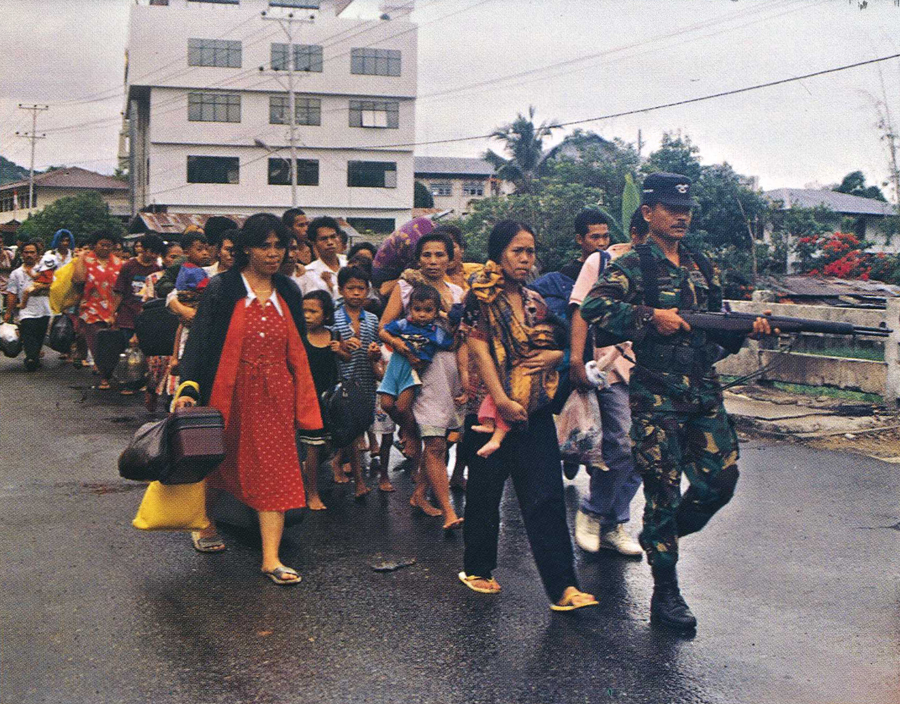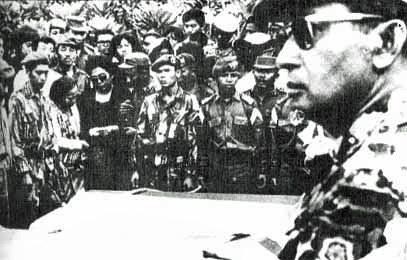|
Waeapo River
The Waeapo River is a river which flows on the island of Buru, Maluku, Indonesia. It is one of the main rivers of the island, draining towards the Banda Sea in the northeast of the island. History Following the communist purges in the 1960s, thousands of political prisoners were incarcerated in Buru, and they were mostly placed around the Waeapo River valley. This was partly due to the valley's topographic features, being surrounded by continuous steep cliffs. As the river was navigable, it was used to transport prisoners inland. The lower Waeapo valley later became a destination for Javanese transmigrants, with over 20,000 settlers moving into settlements on the Waeapo River's floodplain and establishing rice fields. The Waeapo valley remains the concentration of nearly all rice agriculture in Buru. Since 2012, due to gold mining activities in a nearby mountain, mercury has begun leaching into the river, although 2015 measurements indicated acceptable levels. Further illegal go ... [...More Info...] [...Related Items...] OR: [Wikipedia] [Google] [Baidu] |
Indonesia
Indonesia, officially the Republic of Indonesia, is a country in Southeast Asia and Oceania between the Indian and Pacific oceans. It consists of over 17,000 islands, including Sumatra, Java, Sulawesi, and parts of Borneo and New Guinea. Indonesia is the world's largest archipelagic state and the 14th-largest country by area, at . With over 275 million people, Indonesia is the world's fourth-most populous country and the most populous Muslim-majority country. Java, the world's most populous island, is home to more than half of the country's population. Indonesia is a presidential republic with an elected legislature. It has 38 provinces, of which nine have special status. The country's capital, Jakarta, is the world's second-most populous urban area. Indonesia shares land borders with Papua New Guinea, East Timor, and the eastern part of Malaysia, as well as maritime borders with Singapore, Vietnam, Thailand, the Philippines, Australia, Palau, and India ... [...More Info...] [...Related Items...] OR: [Wikipedia] [Google] [Baidu] |
Maluku (province)
Maluku is a province of Indonesia. It comprises the central and southern regions of the Maluku Islands. The main city and capital of Maluku province is Ambon on the small Ambon Island. The land area is 62,946 km2, and the total population of this province at the 2010 census was 1,533,506 people, rising to 1,848,923 at the 2020 Census. The official estimate as at mid 2021 was 1,862,626. Maluku is located in Eastern Indonesia. It is directly adjacent to North Maluku and West Papua in the north, Central Sulawesi, and Southeast Sulawesi in the west, Banda Sea, East Timor and East Nusa Tenggara in the south and Arafura Sea and Papua in the east. Maluku has two main religions, namely Islam which at the 2020 Census was adhered to by 52.85% of the population of the province and Christianity which is embraced by 46.3% (39.4% Protestantism and 7.0% Catholicism). Maluku is recorded in the history of the world due to conflict or tragedy of humanitarian crisis and sectarian conflict ... [...More Info...] [...Related Items...] OR: [Wikipedia] [Google] [Baidu] |
Buru Regency
Buru Regency is a regency of Maluku province, Indonesia. When it was first created on 4 October 1999, the regency encompassed the entire island (plus outlying islands, of which Amalau is the largest); but on 24 June 2008 the southern 40% of the island was split off to form a separate Buru Selatan (''South Buru'') Regency. The residual Buru Regency comprises the northern 60% of the island of Buru and covers an area of 7,595.58 km2. The population at the 2010 census was 108,445 and at the 2020 census this had increased to 135,238. The principal town lies at Namlea. Administrative Districts At the time of the 2010 census the Buru Regency was divided into five districts A district is a type of administrative division that, in some countries, is managed by the local government. Across the world, areas known as "districts" vary greatly in size, spanning regions or counties, several municipalities, subdivisions o ... (''kecamatan''), but subsequently this has been increased ... [...More Info...] [...Related Items...] OR: [Wikipedia] [Google] [Baidu] |
South Buru Regency
South Buru Regency is a regency of Maluku, Indonesia. It was created on 24 June 2008 by being split off from the existing Buru Regency. It is located on the island of Buru, of which it comprises the southern 40%. The Regency (which includes the smaller island of Ambalau to the southeast of Buru Island) covers an area of 5,060 km2, and it had a population of 53,671 at the 2010 Census, rising to 75,410 at the 2020 Census. The principal town lies at Elfule in Namrole District. Administrative Districts At the time of the 2010 Census the regency was divided into five districts (''kecamatan''), but a sixth district (Fena Fafan) has been added by the splitting of the existing Leksula District. The six districts are tabulated below with their areas and their populations at the 2010 Census and the 2020 Census.Badan Pusat Statistik, Jakarta, 2021. The table also includes the location of the district headquarters, the number of administrative villages (rural ''desa'' and urban ''kelurahan' ... [...More Info...] [...Related Items...] OR: [Wikipedia] [Google] [Baidu] |
Banda Sea
The Banda Sea ( id, Laut Banda, pt, Mar de Banda, tet, Tasi Banda) is one of four seas that surround the Maluku Islands of Indonesia, connected to the Pacific Ocean, but surrounded by hundreds of islands, including Timor, as well as the Halmahera and Ceram Seas. It is about 1000 km (600 mi) east to west, and about 500 km (300 mi) north to south. Extent The International Hydrographic Organization (IHO) defines the Banda Sea as being one of the waters of the East Indian Archipelago. The IHO defines its limits as follows: ''On the North'' The Southern limits of the Molukka Sea and the Western and Southern limits of the Ceram Sea. ''On the East.'' From Tg Borang, the Northern point of Noehoe Tjoet Kai_Besar">/nowiki>Kai_Besar.html" ;"title="Kai_Besar.html" ;"title="/nowiki>Kai Besar">/nowiki>Kai Besar">Kai_Besar.html" ;"title="/nowiki>Kai Besar">/nowiki>Kai Besar/nowiki>, through this island to its Southern point, thence a line to the Northeast point of F ... [...More Info...] [...Related Items...] OR: [Wikipedia] [Google] [Baidu] |
Buru
Buru (formerly spelled Boeroe, Boro, or Bouru) is the third largest island within the Maluku Islands of Indonesia. It lies between the Banda Sea to the south and Seram Sea to the north, west of Ambon and Seram islands. The island belongs to Maluku province and includes the Buru and South Buru regencies. Their administrative centers, Namlea and Namrole, respectively, have ports and are the largest towns of the island, served by Namlea Airport and Namrole Airport. About a third of the population is indigenous, mostly Buru, but also Lisela, Ambelau and Kayeli people. The rest of population are immigrants from Java and nearby Maluku Islands. Religious affiliation is evenly split between Christianity and Sunni Islam, with some remnants of traditional beliefs. While local languages and dialects are spoken within individual communities, the national Indonesian language is used among the communities and by the administration. Most of the island is covered with forests rich in tropic ... [...More Info...] [...Related Items...] OR: [Wikipedia] [Google] [Baidu] |
Indonesian Mass Killings Of 1965–66
The Indonesian mass killings of 1965–66, also known as the Indonesian genocide, Indonesian Communist Purge, or Indonesian politicide ( id, Pembunuhan Massal Indonesia & Pembersihan G.30.S/PKI), were large-scale killings and civil unrest primarily targeting members of the Communist Party of Indonesia (PKI). Other affected groups included communist sympathisers, Gerwani women, ethnic Javanese Abangan, ethnic Chinese, atheists, alleged " unbelievers" and alleged leftists. It is estimated that between 500,000 to 1,000,000 people were killed during the main period of violence from October 1965 to March 1966. The atrocities were instigated by the Indonesian Army under Suharto. Research and declassified documents demonstrate the Indonesian authorities received support from foreign countries such as the United States and the United Kingdom. It began as an anti-communist purge following a controversial attempted ''coup d'état'' by the 30 September Movement. According to the most ... [...More Info...] [...Related Items...] OR: [Wikipedia] [Google] [Baidu] |
Transmigration Program
The transmigration program ( id, , from Dutch, ''transmigratie'') was an initiative of the Dutch colonial government and later continued by the Indonesian government to move landless people from densely populated areas of Indonesia to less populous areas of the country. This involved moving people permanently from the island of Java, but also to a lesser extent from Bali and Madura to less densely populated areas including Kalimantan, Sumatra, Sulawesi, Maluku and Papua. The program is currently coordinated by Ministry of Villages, Development of Disadvantaged Regions, and Transmigration. The stated purpose of this program was to reduce the considerable poverty and overpopulation on Java, to provide opportunities for hard-working poor people, and to provide a workforce to utilize better the natural resources of the outer islands. The program, however, has been controversial as fears from native populations of " Javanization" and "Islamization" have strengthened separatist m ... [...More Info...] [...Related Items...] OR: [Wikipedia] [Google] [Baidu] |
Alluvial Plain
An alluvial plain is a largely flat landform created by the deposition of sediment over a long period of time by one or more rivers coming from highland regions, from which alluvial soil forms. A floodplain is part of the process, being the smaller area over which the rivers flood at a particular period of time, whereas the alluvial plain is the larger area representing the region over which the floodplains have shifted over geological time. As the highlands erode due to weathering and water flow, the sediment from the hills is transported to the lower plain. Various creeks will carry the water further to a river, lake, bay, or ocean. As the sediments are deposited during flood conditions in the floodplain of a creek, the elevation of the floodplain will be raised. As this reduces the channel floodwater capacity, the creek will, over time, seek new, lower paths, forming a meander (a curving sinuous path). The leftover higher locations, typically natural levees at the margins ... [...More Info...] [...Related Items...] OR: [Wikipedia] [Google] [Baidu] |
Monsoon
A monsoon () is traditionally a seasonal reversing wind accompanied by corresponding changes in precipitation but is now used to describe seasonal changes in atmospheric circulation and precipitation associated with annual latitudinal oscillation of the Intertropical Convergence Zone (ITCZ) between its limits to the north and south of the equator. Usually, the term monsoon is used to refer to the rainy phase of a seasonally changing pattern, although technically there is also a dry phase. The term is also sometimes used to describe locally heavy but short-term rains. The major monsoon systems of the world consist of the West African, Asia–Australian, the North American, and South American monsoons. The term was first used in English in British India and neighboring countries to refer to the big seasonal winds blowing from the Bay of Bengal and Arabian Sea in the southwest bringing heavy rainfall to the area. Etymology The etymology of the word monsoon is not wholl ... [...More Info...] [...Related Items...] OR: [Wikipedia] [Google] [Baidu] |
Mangrove Swamp
Mangrove forests, also called mangrove swamps, mangrove thickets or mangals, are productive wetlands that occur in coastal intertidal zones. Mangrove forests grow mainly at tropical and subtropical latitudes because mangroves cannot withstand freezing temperatures. There are about 80 different species of mangroves, all of which grow in areas with low-oxygen soil, where slow-moving waters allow fine sediments to accumulate.What is a mangrove forest? National Ocean Service, NOAA. Updated: 25 March 2021. Retrieved: 4 October 2021. Many mangrove forests can be recognised by their dense tangle of prop roots that make the trees appear to be standing on stilts above the water. This tangle of roots allows the trees to handle the daily rise and fall of tides, which means that most mangroves get flooded at least twice per day. ... [...More Info...] [...Related Items...] OR: [Wikipedia] [Google] [Baidu] |








